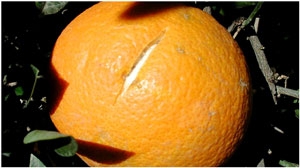
In short, reasonable cultural practices to avoid extreme fluctuation in soil moisture and fertilization levels throughout the growing season may help to minimize fruit split. Regular irrigation is key.
As the tree requires more water, it takes from the fruit, which in turn becomes soft and the tree leaves begin to cup. If a large amount of water is added soon after, the fruit swells beyond the skin's capacity and splitting occurs.

Try the Fullerton Arboretum where they have over 3000 plants and a couple dozen cycads.
This is a cycad from the Zamiaceae family and is called an Encephalartosferox and is one of the many cycads you will find growing there.

The California drought is a very serious issue that impacts all Californians. Even with the recent rainstorm and snow, we will be fortunate to surpass the rain level of 1976-1977, one of the worst droughts on record in California. Drought restrictions can be complex and confusing.Since voluntary or mandatory drought restrictions are often drafted and implemented locally the best way for you to stay informed is to contact your local water provider.
Plants that do not receive enough water due to drought or governmental restrictions aimed atwater conservation will eventually show signs of water stress. Although plants vary in the amount of water they require for optimal growth and development, most exhibit characteristic symptoms when they are in need of water. Because plants need to be watered at an early stage of water deficit to prevent irreversible damage, it is crucial to check plants regularly for symptoms of drought, preferably during the afternoon when symptoms are most evident.
Common symptoms include:
- wilting or drooping leaves that do not return to normal by evening
- curled or yellow leaves that may fold or drop, or foliage that becomes grayish and loses its green luster
- new leaves that are smaller or stem sections that are closer together than normal
- lawn grasses that retain a footprint for several minutes
Read full text and learn more about Keeping Landscape Plantings Alive under Drought or Water Restrictions.

In California, under Health and Safety Code § 17922.12, graywater is defined as “untreated wastewater that has not been contaminated by any toilet discharge, has not been affected by infectious, contaminated, or unhealthy bodily wastes, and does not present a threat from contamination by unhealthful processing, manufacturing, or operating wastes. Graywater includes, but is not limited to, wastewater from bathtubs, showers, bathroom washbasins, clothes washing machines, and laundry tubs, but does not include wastewater from kitchen sinks or dishwashers.”
Currently, a permit is no longer required for the installation of a single-family or two-family residential graywater irrigation systems from a simple clothes washing graywater system as long as it does not require cutting of the existing plumbing piping.
All other systems require a construction permit prior to erection, retrofitting, construction and installation as stated in the actual code. The full text of these standards can be viewed at the California Department of Housing and Community Development (HCD) Division of Codes and Standards website, http://www.hcd.ca.gov/codes. Because these regulations may change at any time, always check with HCD and local enforcement agencies before developing plans for or installing a graywater system. Cities and counties can impose stricter guidelines than the state, so homeowners interested in installing graywater systems should contact their local jurisdiction for specific regulations concerning graywater handling and use.
Laundry-to-landscape graywater systems are relatively simple to install and are inexpensive. The hose exiting the clothes washing machine is attached to a valve that separates graywater from water destined for the sewer. The graywater is diverted through a 1-inch main irrigation line with ½-inch tubing outlets placed throughout the landscape terminating in a valve box set in what is termed a “mulch basin” that surrounds plants being watered (see below). The washing machine pump distributes water directly to the landscape with no filter.A vacuum break or backflow prevention device may also be needed. Keep in mind that salt-free and boron-free liquid laundry detergents should be used for irrigating the landscape. In addition, chlorine bleach should be avoided.



